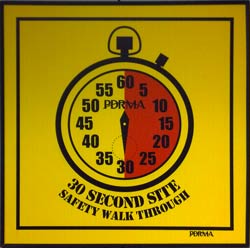 
Focusing on Plans of Action
Plans of Action (POA) are an important part of the PDRMA Loss Control Review (LCR) and help members stay focused on specific causes of past losses and exposures the agency identified with the help of their Risk Management Consultant. A key to continued improvement in preventing injuries and other losses is maintaining a focus on POAs during the three years in between LCRs.
According to Tanya Brady, Manager of Risk Management at the Waukegan Park District, it’s simply a matter of keeping POAs in the forefront. “We have an extensive list of ongoing safety goals for the year. It’s three or four single-spaced pages – it’s actually longer than the POAs provided by PDRMA. Our Safety Committee meets monthly to report on POA progress, and we indicate which goals relate to our LCR, so we are all aware of what must be done before our next review in 2015.”
That Creative Solution May Be Grant Worthy
Whether it’s a new way to address a POA or a creative solution you see during a PIPP observation, be sure to share those ideas with other PDRMA members. Submit them to PDRMA’s Risk Management Grant and Recognition Program, and your agency might receive a $500 or greater award. Download LRN #768 for submission criteria, and be sure to submit your application to Tim Lenac by Sept. 12, 2014. |

The advantage of this approach, Brady notes, is that the POA items are always on the safety agenda and always updated even if the progress is incremental. “We measure our progress in action steps with deadlines. Some POAs need budget or input from certain departments. We note the progress toward each goal monthly. That way, we can stay on track.”
Brady notes that the Safety Goal List is the only tool Waukegan uses. She added PDRMA POAs to those goals after realizing how completing them affected the agency’s LCR score. “After Jackie (Pierce, PDRMA Risk Management Consultant) did our LCR in 2012, I decided the best way to stay on top of it was to keep it in front of everyone by putting it in our Safety Goal List to review each month.
“Next year is our LCR review year, and we’ve been concentrating on the PDRMA items with end dates leading up to the review time,” explains Brady. “Little by little we’re making progress. We hope to get the points we need to maintain a high score. But it’s really more than just about the score. We’ve been steadily reducing the number of on-the-job injuries – none so far in 2014. PDRMA does a great job of outlining what we need to do,” she adds, “and we have a dedicated staff really committed to going above and beyond to make it all happen.”
Brady offered some tips to help other agencies stay on track:
Keep it simple: The Safety Goal List is really the only tool Waukegan uses, and it incorporates POAs.
Keep it accountable: The Safety Committee meets each month and every person must report on the progress of the goals in their area.
Break down big items and track progress: Every step is progress, even if it’s a meeting; many times the committee breaks out the action items needed to accomplish a PDRMA POA or other agency safety goal.
Think outside of the box: Waukegan looks for creative solutions that work. For instance, one POA was to implement the 30 Second Site Safety Survey program. The agency used PDRMA’s online video to train staff and purchased the stickers as reminders. But to make sure the message went out consistently, the agency included it in its department handbooks. Waukegan is also making it part of its new employee Safety Orientation process and is including the PDRMA video in its 2014 updated Safety Orientation video. Incorporating the 30 Second Site Safety Survey into the agency’s procedures assures a consistent message, frees up supervisors’ time for other tasks, and makes sure it’s not forgotten.
Leverage the solutions: Use what works to achieve consistency and manage risks. One POA action item was to add a column to the sled hill inspection form to show completed work. Waukegan decided to have consistent content for all inspection forms and added that column to all the forms, so that corrective actions are not only completed but documented as well. |

